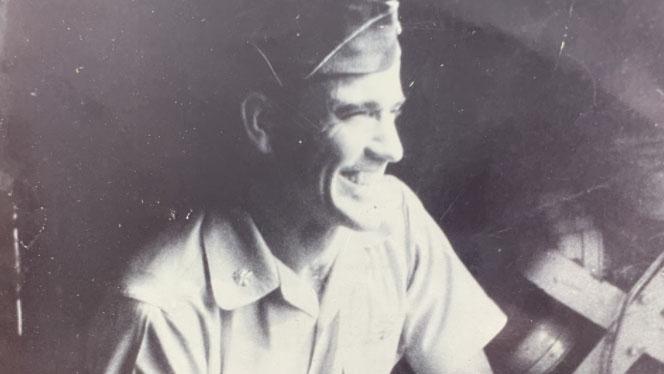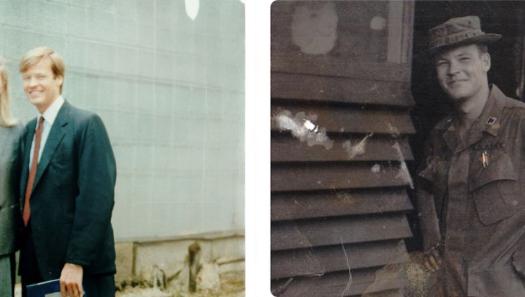Military & Veterans News
Cover Story: A Crew Together

This is a story to recognize the passing of the last survivor of a miraculous rescue mission behind enemy lines during World War II 76 years ago.
Robert Coates (pictured here), the youngest of five siblings, was seventeen years old in 1943 when he misled his mother into letting him sign enlistment papers for the Army Air Corps. Growing up on a farm in Phoenix, Arizona west of the Sky Harbor Airport, which was the site of much aerobatic flying in the 1930’s, Bob wanted early to fly, to be a pilot. When World War II began, it afforded Coates the perfect opportunity to fulfill his dream to fly a military airplane.
Coates was required to pass through an arduous training process that weeded out many other applicants at each step, culminating in flight school and flight training. This lasted nine months with three months of primary, three months of basic, and three months of advanced training. Each pilot had 65 flying hours of primary training and 75 hours of both basic and advanced training.
After selection, student pilots progressed through several stages of training. Tests and examinations had to be successfully passed before the next level of instruction could be undertaken.
During basic training at Elementary Training Schools, students learned the basics of how to fly an aircraft such as the de Havilland Tiger Moth. They also flew their first solo flight. Advanced training at Service Flying Training Schools introduced pupils to more powerful aircraft such as the North American Harvard. At both the elementary and advanced levels, classroom-based lessons continued in various subjects and simulation flying (or link trainer instruction) was mandated.
Meeting all the requirements to become a pilot, Coates soon found himself an Air Corps second lieutenant and flying the latest model of the “Flying Fortress,” the B-17G.
Fast forward to 1944 and aerial deployment to the American airfield at Cambridge in Great Britain flying against German military targets. Coates had previously assembled his crew of nine, which would remain together for the war and beyond. They picked up their “Fortress” at the factory near Seattle, Washington and flew from there to England, taking a circuitous route dictated by the late season and a chance encounter with inclement weather. Touching down in Florida, they then flew on to an American air base in Brazil and continued from there to a British airfield in West Africa.
When Coates and crew arrived at their final destination, it was learned that bomber crews no longer flew just 25 missions before returning to the United States. So, on January 21, 1945, Coates’s aircraft flew its 47th mission. Assigned to the 533rd Squadron of the 8th Air Force’s 381st Bomber Group, that mission took them to Aschaffenburg in Southwest Germany to bomb an ordinance depot and a factory that was building armored fighting vehicles.
The mission after-action report for the bombers cited 38 B-17G’s taking off from England. Flying to the target, two aircraft aborted the mission and failed to attack. Of the remainder, one aircraft was noticed to have been lost to an unknown cause although there was no evidence that it was a casualty of German anti-aircraft gunfire or enemy fighters, or a combination of both. The report listed nine men missing, parachutes not having been observed. The missing aircraft was Coates’s.
End of story? No.
After hitting their assigned targets, on Coates’ B-17G return flight, one of the aircraft’s engines malfunctioned. The damage caused the plane to lag behind the remainder of the bomber group and was soon lost to the group’s sight. The aircraft had gone “missing.” But it was still flying and did so until the plane passed over the French-German border near the German city of Saareguemines, a sector being fought over by the German XIII SS Corps and the American Seventh Army’s XXI Corps. It also had become obvious that the bomber was not going to make it back to England. Coates was faced with the choice of either having the crew bail out, landing in enemy territory, or to crash land as close to American lines as possible. He chose to crash land the plane, taking the chance that he and his crew would end up as prisoners of war.
Surviving the Crash
Coates skillfully guided the B-17G to a safe crash landing in a field that was behind a German minefield. Gathering his still intact air crew together and not being accosted by any enemy soldiers, he started to trek westward towards American lines. Before they could get far, they were fired on by American soldiers. They quickly took to the ground and then heard shouts in English. The loud message was that the crew was about to walk into the German minefield. Assessing their precarious situation, the crew took an alternate route to American lines where they were picked up and driven in an army truck to a Seventh Army command post.
As aircraft commander, Coates rode in the truck’s cabin. The driver and Coates soon engaged in conversation wherein Coates told him his name. “Oh,” said the driver, “we have a Bruce Coates in the unit, could you be related?” Small chance that two brothers with the same name and hometown would meet under these circumstances.
When they reached the command post, Bruce was not there. Ironically, he had gone to pick up a downed American aircraft crew! When he returned, the surprise on the part of Coates and Bruce was palpable. They were indeed brothers, Bruce being just a year or so older than Bob.
The clincher to this true wartime tale, however, is not only did Coates and his crew safely survive the war, and Coates had the unlikely and serendipitous experience of meeting his brother Bruce, but that they reunited every year until the last member of Coates’ crew died, save Coates himself. Bob Coates, who just passed away last month at 97, was the last living survivor.
Had their B-17G Flying Fortress not been safely landed, albeit in enemy territory, those annual meetings would never have taken place.
The unique Robert and Bruce Coates meeting was truly exceptional but so was “a crew together, to the very last.”
Editor’s note: Brig. General (Ret.) Raymond E. Bell, Jr., PhD, is a writer noted for his breadth of publications that includes more than 300 pieces covering a wide variety of World War II historical events and current military subjects. Raymond Bell, Jr. graduated from the U.S. Military Academy at West Point, Class of 1957. Learn firsthand about his background and upbringing as son of U.S. Army Major General Raymond Bell, U.S. Military Academy at West Point, Class of 1927 at https://www.youtube.com/watch?v=QHxujFdJsK0


